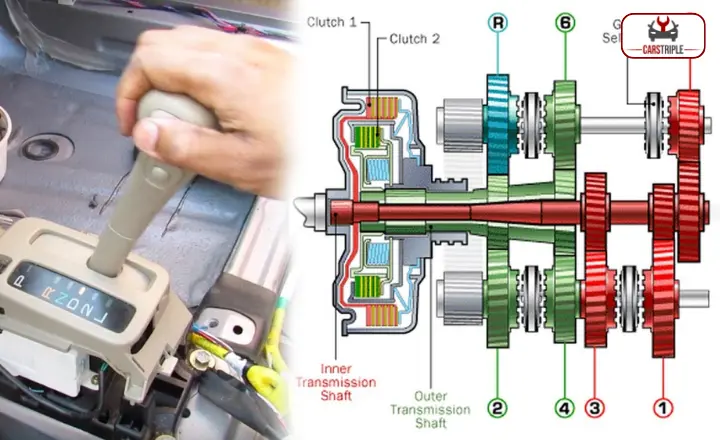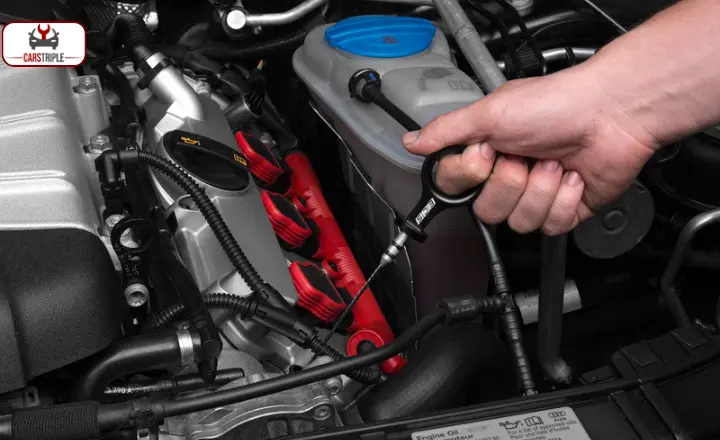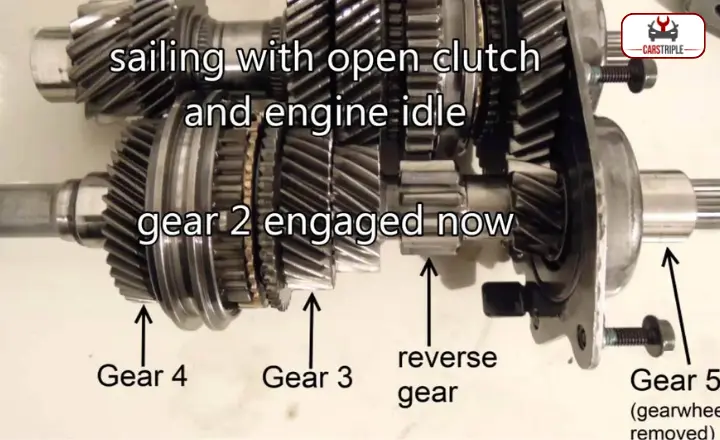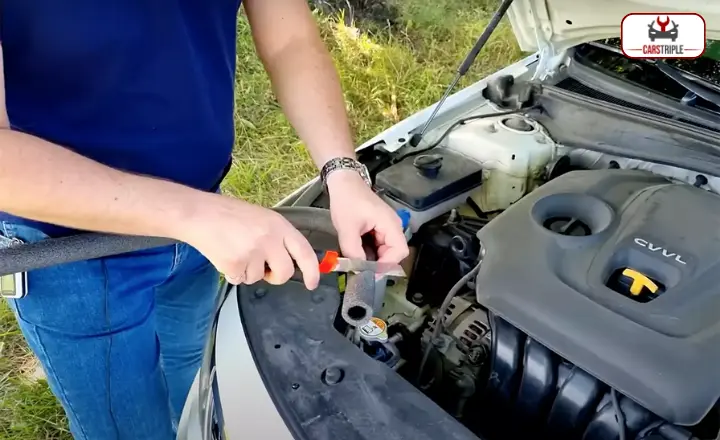The consequences of Having Symptoms Of Too Much Transmission Fluid can be surprisingly detrimental to your vehicle’s performance and, ultimately, your wallet. Imagine driving down the road as smoothly as ever when suddenly you notice strange noises or jerky movements coming from your car. These are just a few potential symptoms of an overfilled transmission system.
In this guide, we will explore the signs and implications of excessive transmission fluid, offering practical advice on what you should do if you suspect your car has been overfilled – because knowing how to address this issue could save you from costly repairs in the long run.
How Often Should You Change Your Transmission Fluid?
Regular transmission fluid maintenance is essential for your vehicle’s overall health and performance. Unlike motor oil, transmission fluid doesn’t need to be changed as frequently, but it still requires attention to ensure that it’s fresh and clean.
Most manufacturers recommend changing the transmission fluid every 30,000 to 60,000 miles, but this can vary depending on driving conditions and your vehicle type.
- One key reason for changing your transmission fluid is that, over time, the fluid breaks down due to heat and friction.
- When this happens, the lubricating properties decrease, reducing power or performance.
- Old or contaminated transmission fluid can lead to excessive wear on crucial components within your transmission system.
- Symptoms of too much transmission fluid may include gear slippage, erratic shifting patterns, or even a burning smell coming from under your hood.
Transmission fluid changes and paying attention to these symptoms of too much or too little transmission fluid can help maximize the lifespan and performance of your vehicle’s vital components while avoiding costly repairs.

The frequency of transmission fluid change is determined by two variables that are related to the symptoms of excessive transmission fluid:
- Excessive transmission fluid symptoms
- Driving style impact on car’s transmission
- Car make and model influence on transmission
Car manufacturers have long advocated the importance of addressing harsh weather conditions, stop-and-go driving, and towing heavy loads when it comes to vehicle maintenance. These factors significantly stress a vehicle’s transmission system, leading to wear and tear if not properly addressed.
Symptoms of too much transmission fluid can include noticeable issues such as slipping gears, rough shifting, or surging while driving at consistent speeds. Excess fluid can lead to foam formation inside the gearbox, further deteriorating its performance.
To avoid these problems, car owners should adhere to their vehicle manufacturer’s guidelines for scheduled maintenance and take proactive measures such as regular fluid checks and changes based on usage patterns.
Here Is An Essential You Need For Your Car!
If you’ve noticed strange symptoms in your car, such as difficulty changing gears, transmission slipping, or overheating, the culprit could be too much transmission fluid. Excess fluid can cause foaming and aeration, leading to decreased lubrication and potential damage to the transmission system.
To address this issue promptly because too much fluid can create excessive pressure that may result in seals blowing out or other internal components failing. By being aware of these symptoms of an overload of transmission fluid, you can take proactive measures to ensure the health and longevity of your vehicle’s transmission.
Overlooking the signs of excessive transmission fluid can lead to costly repairs and even complete transmission failure. Every car owner must regularly check their transmission fluid levels and condition. This simple preventative measure can save you from major headaches down the road and keep your vehicle running smoothly for years to come.

So next time you notice any unusual behavior from your car’s transmission, don’t ignore it—take action immediately by checking your transmission fluid levels and consulting with a professional if needed. Your wallet and vehicle will thank you in the long run!
How To Know If Your Transmission Fluid Is Low
The most telling signal is difficulty shifting gears or the transmission slipping, indicating that the fluid level cannot lubricate and cool the system effectively. A noticeable delay in response when going from park to drive or vice versa could also point towards low transmission fluid. Keep an eye out for burnt or unusual smells from your vehicle, as this may indicate that the transmission fluid is overheating due to insufficient levels.
Having too much transmission fluid can also lead to its own set of problems. Excessive foaming of the fluid can occur, causing inadequate lubrication and potential damage to internal components. Leaks may develop if there’s too much pressure within the system. Therefore, it’s crucial to maintain the correct amount of transmission fluid to avoid both low and high levels leading to potentially costly issues down the road.

So, how can you tell that your transmission fluid is low? Below are just a few of the tell-tale signs:
- Check for difficulty shifting gears: If you notice your vehicle having trouble changing gears, jerking, or hesitating when you go, this could be a sign that your transmission fluid is running low. This lack of lubrication can cause the gears to grind and lead to potential transmission damage.
- Monitor for unusual noises: Unusual sounds like whining, humming, or clunking from your vehicle could indicate low transmission fluid levels. These noises often occur when there isn’t enough fluid to lubricate and cushion the moving parts within the transmission properly.
- Pay attention to overheating: Low transmission fluid can cause the transmission to overheat, resulting in a burning smell inside your vehicle and even smoke from under the hood. Overheating can lead to severe damage if not addressed promptly.
By keeping an eye (and ear) out for these tell-tale signs of low transmission fluid, you can avoid potentially costly repairs and maintain your vehicle running smoothly.
1. Increased Transmission Fluid Pressure
Increased transmission fluid pressure in automotive components can lead to symptoms that indicate potential issues with the vehicle’s transmission system.
- One common symptom of too much transmission fluid pressure is harsh or delayed shifting, as the excess pressure can cause the gears to engage more forcefully than necessary.
- Another symptom to look out for is fluid leaks around the seals and gaskets of the transmission. The increased pressure within the system can strain these components, leading to potential leaks that may manifest as spots or puddles of red fluid underneath the vehicle.
- Too much transmission fluid pressure can also cause overheating of the transmission, which may result in a burning smell emanating from the engine bay and potentially even more severe damage if not addressed promptly.
Car owners and technicians must be aware of these symptoms, as they could indicate a need for adjustments or repairs to alleviate the excess pressure within the transmission system. Proactive monitoring and maintenance can prevent further damage and ensure this critical automotive component’s smooth, efficient operation.
2. Overheated Transmission
When a transmission gearbox is inadequately lubricated, the consequences can be dire. One common issue in this situation is overheating, which occurs when the fluid levels are insufficient to cool and lubricate the moving parts properly. This leads to increased friction and heat buildup within the gearbox, ultimately putting the entire system at risk of breaking down.
Fluid leakage from the gearbox due to broken seals exacerbates the problem further. Not only does this lead to a loss of crucial transmission fluid, but it also introduces potential contaminants into the system, compromising its overall effectiveness. Drivers may experience gear slipping, erratic shifting, or even complete transmission failure.

The impact of inadequate lubrication and fluid leakage on a transmission gearbox cannot be overstated—vehicle owners need to stay vigilant for these signs and address them promptly before they escalate into costly repairs or replacements.
3. Transmission Failure
Transmission failure can be a nightmare for any vehicle owner, especially due to leaking or broken seals and increased fluid pressure. These issues often indicate more significant transmission system problems requiring immediate attention.
Leaking or broken seals can lead to a loss of transmission fluid, causing friction and heat buildup within the transmission, ultimately resulting in premature wear and tear on vital components.
Increased fluid pressure puts excessive strain on the transmission system, leading to symptoms such as harsh shifting, slippage, and even complete failure if left unattended. These symptoms affect your vehicle’s performance and pose safety hazards for you and others on the road.
To address these issues promptly, seek professional help to diagnose and rectify the underlying causes before they escalate into more severe and costly problems.
Understanding the symptoms of too much transmission fluid is crucial for maintaining a healthy vehicle. By staying vigilant for signs of leaking or broken seals and monitoring fluid pressure, you can save yourself from costly repairs while ensuring your safety on the road. Regular maintenance checks and prompt action in response to these symptoms are key to preserving the longevity and efficiency of your vehicle’s transmission system.
Excessive Transmission Wear
Excessive transmission wear lubrication can lead to various symptoms, including increased slippage, erratic shifting, and overheating. When there is too much transmission fluid, the gears may not engage properly, causing the vehicle to struggle when accelerating or climbing hills.
Overfilled transmission fluid can form foam within the system, leading to inadequate lubrication and potential damage. One often overlooked symptom of too much transmission fluid is a noticeable increase in temperature. The excessive lubricant can create added friction and heat and strain the entire transmission system.

Vehicle owners must regularly monitor their transmission fluid levels and adhere to manufacturer specifications for proper maintenance. Proactively addressing excessive transmission wear lubrication issues will help avoid costly repairs.
Slightly Overfilled Transmission?
Regarding transmission fluid levels, too much can be just as problematic as too little. One of the key symptoms of an overfilled transmission is excessive pressure within the system, which can lead to fluid leaks and potential damage to the seals. A slightly filled message may cause foaming of the fluid, leading to decreased lubrication and possible overheating of the transmission components.
Too much transmission fluid makes shifting gears or erratic gear changes difficult. This occurs because the excess fluid can interfere with the normal hydraulic function of the transmission, resulting in delayed or rough gear engagements. It’s important to address these issues promptly, as prolonged driving with overfilled information can lead to serious damage and costly repairs in the long run.
While adding extra fluid is a quick fix for a low level, it’s essential to maintain proper levels for optimal performance. Awareness of these symptoms will help you identify potential issues early on and prevent further damage to your vehicle’s transmission system.
1. High-Level Dipstick
High-Level Dipstick, a dipstick for high-level readings, is an innovative tool designed to measure fluid levels accurately and precisely in various automotive systems. One of the key benefits of using a High-Level Dipstick is its ability to detect slight overfills in transmission fluids.
Unlike traditional dipsticks that may not be sensitive enough to detect minor overfills, the High-Level Dipstick is engineered with advanced technology that ensures reliable readings. By incorporating this tool into regular maintenance routines, vehicle owners can proactively monitor and manage their transmission fluid levels more effectively.
This proactive approach not only helps prevent potential issues associated with overfilled transmissions but also contributes to extending the lifespan of the vehicle’s transmission system.

Utilizing a high-level dipstick can provide peace of mind for mechanics and car owners alike, knowing they have access to precise information about their transmission fluid levels. This level of accuracy empowers individuals to make informed decisions regarding any necessary adjustments or maintenance tasks, ultimately leading to better overall performance and longevity for their vehicles.
2. Difficulties in Shifting & Changing Gears
The transmission system of a vehicle plays a crucial role in ensuring smooth gear shifts and optimal performance. One commonly overlooked aspect of this system is the transmission fluid, lubricant, and coolant for the gears. Difficulties can arise when the transmission fluid is slightly overfilled.
While many drivers may see overfilling as a harmless mistake, it can lead to serious issues such as foaming, overheating, and loss of lubrication efficiency within the gears.
When the transmission fluid becomes slightly overfilled, it creates excessive pressure within the system, leading to foaming. This foam can negatively impact the fluid’s ability to properly lubricate the gears, increasing wear and tear on internal components.
The overheating caused by excess fluid can further degrade its lubricating properties, potentially leading to costly repairs. Therefore, maintaining proper transmission fluid levels is essential for ensuring smooth gear shifts and preventing long-term damage to your vehicle’s transmission system.
3. Fluid Leakage
Regarding vehicle maintenance, fluid leakage, and inadequate lubrication can be a nightmare for car owners. Whether it’s the result of a slightly overfilled transmission or another issue, the consequences can be costly and dangerous. Beyond the obvious mechanical implications, such as reduced performance and potential engine damage, environmental concerns are at play.
The seepage of fluids like oil or coolant can contaminate water sources and harm wildlife if not properly addressed. Inadequate lubrication leads to increased friction and compromises the vehicle’s overall safety. Without proper lubrication, components within the engine may wear down more quickly, leading to unexpected breakdowns or malfunctions on the road.
While it’s easy to overlook fluid leakage and inadequate lubrication as minor issues, they have far-reaching implications beyond affecting your vehicle’s performance. By monitoring fluid levels and promptly addressing leaks, drivers safeguard their investments and contribute to environmental conservation efforts.
4. Whining, Grinding, or Humming Transmission Noise
Have you ever heard an unsettling whining, grinding, or humming noise coming from your car’s transmission? While it may be tempting to ignore it, these sounds could indicate a serious issue with your vehicle. One potential cause of these noises could be a slightly overfilled transmission.

Excess fluid can increase pressure within the transmission system, causing the gears and bearings to produce these unnerving sounds. The solution may be as simple as draining some of the excess fluid, but it’s essential to have this issue addressed promptly to prevent further damage.
Transmission noises can also be a signal of impending trouble. Ignoring these warning signs could result in costly repairs; therefore, consult a professional mechanic for an accurate diagnosis and swift resolution if you notice any unusual sounds emanating from your vehicle’s transmission.
5. An Overheating Engine
Many drivers might overlook less obvious causes, such as a slightly overfilled transmission. While this might seem unrelated, the excessive fluid in the news can lead to increased friction and heat, ultimately impacting the entire engine system. This often overlooked issue can manifest as overheating due to the strain on the engine’s cooling capabilities.
Drivers and mechanics must consider all possible factors contributing to an overheating engine, including seemingly unrelated components like the transmission. Beyond just looking at traditional causes like a malfunctioning radiator or coolant leak, paying attention to intricate details such as transmission fluid levels can make a significant difference in identifying and resolving an overheating engine issue.
This fresh perspective highlights the interconnectedness of various vehicle systems and emphasizes that overlooking seemingly minor issues can lead to major problems down the road. By broadening our understanding of potential causes for an overheating engine, we can better equip ourselves to address these issues proactively and prevent costly repairs in the future.
How To Fix An Overfill
If you are dealing with overfilled transmission fluid, there are a few key symptoms to look out for. These include fluid leakage from the dipstick tube or overflow pipe, erratic shifting, or transmission slippage. If left untreated, this overfill can cause damage to the transmission and other components of your vehicle.
Start by draining the excess fluid using a hand pump or siphon to fix an overfill. Getting the levels back within the manufacturer’s recommended range is crucial to ensure proper function and prevent further issues. After draining, check for leaks or damage caused by the overfill and address them promptly.
Once you’ve fixed the overfill issue, it’s important to monitor your vehicle’s performance closely and address any lingering issues as soon as they arise. Regularly monitoring your transmission fluid levels can help prevent future problems and keep your vehicle running smoothly.

1. Park Your Vehicle on a Level Surface
When parking your vehicle, finding a level surface may seem inconsequential, but the impact on your car can be substantial. Parking on uneven ground can cause issues such as fluid leaks, fuel overflow, and even damage to the transmission or brakes. This is particularly important when fixing an overfill situation in your vehicle.
A level surface ensures all vehicle components are properly aligned, preventing potential overflows or leaks. Parking on a level surface is crucial for accurate measurements and adjustments.
Whether it’s an overfilled oil tank or a fuel tank, being on level ground allows you to assess the precise amount of excess fluid and take appropriate steps to rectify the situation without causing further damage. Working on a flat surface provides stability and safety when addressing any spillage or leakage during the fix.
2. Checking the Fluid Level
Overfilling or underfilling can lead to serious engine problems, so it’s important to take a systematic approach. Start by consulting your owner’s manual for the correct procedure and type of fluid required for your specific vehicle. Once you’ve identified the accurate dipstick or fill cap for the liquid you’re checking, ensure the car is on level ground before removing it.
If you’ve overfilled a certain fluid, don’t panic – there are ways to fix this common issue. For example, if you’ve filled your engine oil, drain the excess using an oil extraction pump or loosen the drain plug slightly and let some oil escape until it reaches the proper level.
Remember that meticulous checking and maintaining fluid levels ensures optimal vehicle performance and extends your car’s lifespan. Develop a routine maintenance schedule that includes regular checks of all essential fluids – from engine oil and transmission fluid to coolant and power steering fluid – keeping everything at its optimum for smooth running.

3. Drain or Syphon Excess Fluid
When fixing an overfill, draining or siphoning off excess fluid is a crucial step in preventing potential damage to the system. This task requires precision and care, ensuring that only the right amount of fluid is removed without causing further imbalance.
One must consider the type of system and the appropriate method for drainage or siphoning, whether it be manual extraction or specialized equipment. To remove excess fluid, one should also consider the underlying cause of the overfill.
Understanding why the overfill occurred in the first place can help prevent future occurrences and ensure a more long-term solution. Addressing the symptom and its root cause can effectively rectify overfill issues and maintain optimal system functionality.
4. Re-check Fluid Levels
Re-checking fluid levels in your vehicle is crucial in maintaining optimal performance and preventing potential breakdowns. While most people diligently check their oil levels, it’s also important to regularly inspect other fluids such as coolant, brake, transmission, and power steering.
Keeping these fluids at the proper levels can prevent costly repairs down the road, as low or overfilled fluids can lead to overheating, corrosion, or malfunctioning components. You must promptly address the issue when you discover a filled fluid level in your vehicle.
Overfilling any fluid can result in excessive pressure within the system, which may lead to leaks or damage to seals and gaskets. It’s advisable to consult the vehicle’s manual for specific instructions on safely draining off excess fluid without causing further harm.
The significance of re-checking all critical fluid levels goes beyond standard maintenance—it’s a strategic move toward preserving your vehicle’s health and longevity. Regularly monitoring these essential components gives you valuable insights into your car’s overall condition while proactively addressing any irregularities before they escalate into major problems.
Conclusion
It is important to be mindful of the symptoms associated with Symptoms too much transmission fluid in your vehicle. These symptoms include difficulty shifting gears, transmission slippage, and fluid leaks. Ignoring these signs can lead to serious damage to your vehicle’s transmission system and result in costly repairs.
By staying vigilant and addressing any issues promptly, you can prevent potential long-term damage and ensure the smooth operation of your vehicle’s transmission system. Remember, a well-maintained transmission leads to a smoother driving experience and prolongs the life of your car.
FAQS
What are the Symptoms of too much transmission fluid?
Slipping gears, overheating, and leaking are common symptoms of an overfilled transmission.
Can overfilling transmission fluid cause damage?
Excessive transmission fluid can lead to severe damage by creating pressure and causing foaming.
How do I know if my transmission has too much fluid?
You may notice difficulty shifting gears, strange noises, or a burning smell from the information.
What should I do if I suspect my transmission has too much fluid?
Have a professional mechanic inspect your vehicle to determine the proper transmission fluid level.
Read More:

